I grew up in the South in the Delta Farmland near the Mississippi River, and I have always been enchanted by the Queen City of the Mississippi River–New Orleans, Louisiana. Allow me to begin this post by taking you on a virtual tour of New Orleans:
“They say that New York is a state of mind. Well, in my opinion, New Orleans is the GREATEST state of mind. If you plan to visit New Orleans, you need to get a passport. You have left the USA.” – Jacki Kellum
Indeed, New Orleans fascinates me, and I guess that is why I collect books about New Orleans. Allow me to show you a few:
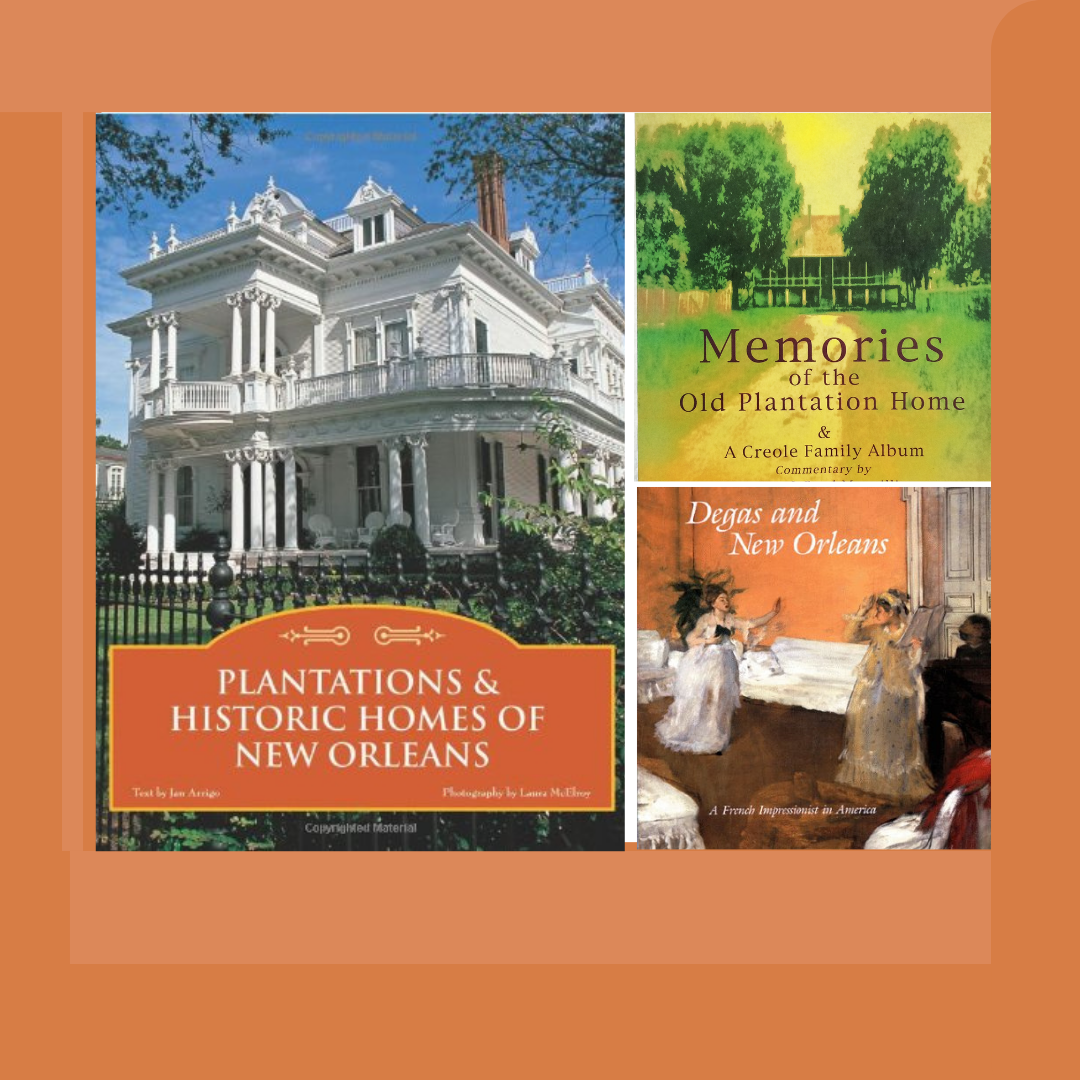
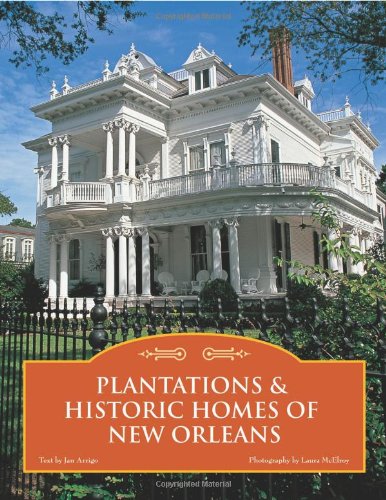
Plantations & Historic Homes of New Orleans
Image Credit: Amazon
“Hurricane Katrina ravaged much of New Orleans in 2005, but thankfully the city’s most treasured historic homes survived. Plantations & Historic Homes of New Orleans is a poignant tribute of these storied mansions, whose architectural beauty brings a unique flair to the Big Easy’s most famous neighborhoods.
“From the French Quarter and Garden District to Uptown, Marigny, and Bayou St. John, many of New Orleans’ grandest old homes and nearby plantations are featured in this book, showcasing the massive brick columns, intricate cast-iron balconies, wide verandas, sumptuous parlors, and humble servants quarters that give this area its charm. Open these pages and you’ll travel to Destrehan, the oldest plantation house in the Mississippi Valley, originally built of hand-hewn bald cypress timber using briquette entre’pateaux,mud (clay, river sand, and Spanish moss) between post; the homes artist Edgar Degas and author William Faulkner lived in during their New Orleans’ stays; and the 1850 House located in the Lower Pontalba building on Jackson Square. Learn about the building’s namesake, a baroness with a tumultuous family life who managed to escape murder and was also responsible for building the American embassy in Paris.” – Amazon
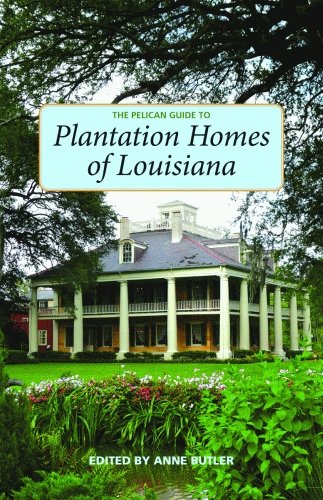
“Featuring homes such as the beautiful Merieult Hoause in the French Quarter and Oaklawn Manor near Bayou Teche, this comprehensive guide highlights the finest plantation homes in all regions of the state. From Natchitoches’s Melrose Plantation to Lafayette’s Alexandre Mouton House, these homes have been an integral part of Louisiana, some from the periods of French and Spanish rule. Butler carefully describes each structure’s architectural uniqueness and relates the home’s significance. She notes private and public plantations and includes updated contact information, all organized by driving tours. This revised edition reflects recent restorations and includes a new section showcasing the homes in New Orleans’ Garden District.” – Amazon

“A fascinating account of Edgar Degas’s 1872 visit to New Orleans, the only time a French Impressionist visited the United States, offers color and black-and-white illustrations that capture the unique connection that existed between the cultures of France and Louisiana.”
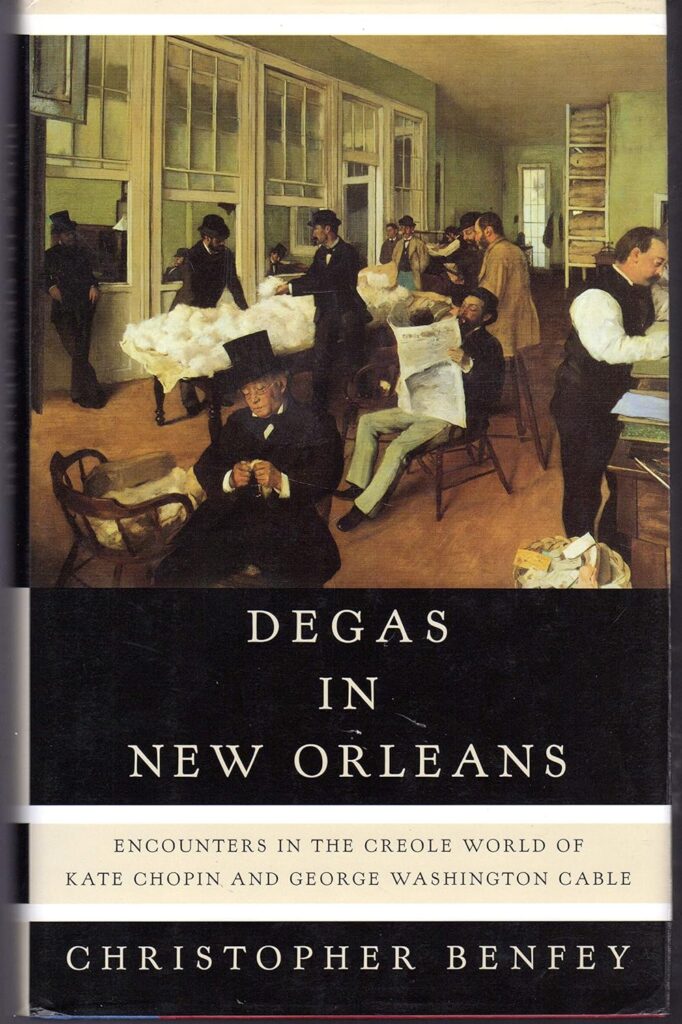
Degas in New Orleans
Image Credit: Amazon
“Describes French artist Edgar Degas’s 1872 visit to relatives in New Orleans, a city caught in a key moment of cultural history and recovering from the turbulence of the Civil War, a time, place, and culture that also inspired the work of American writers Kate Chopin and George Washington Cable.”
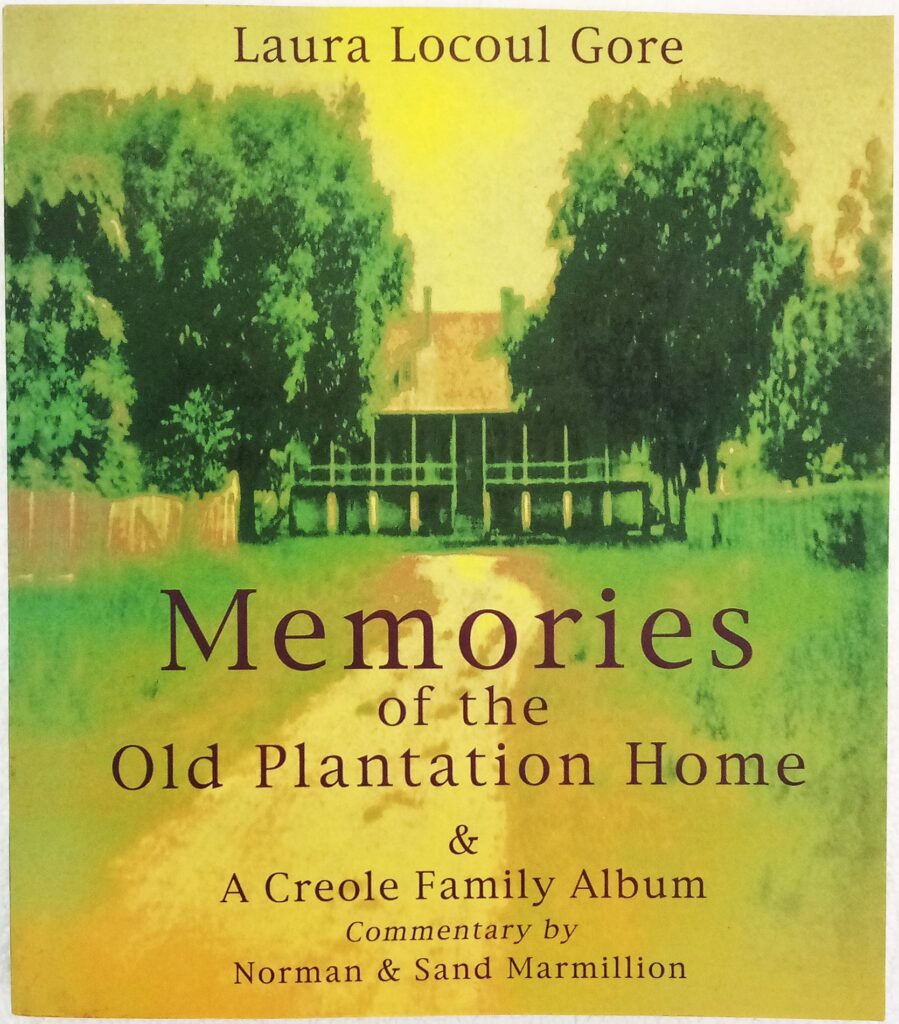
Memories of the Old Plantation Home & A Creole Family Album
This book is written about the Creole Plantation Laura
“In 1936, Laura Locoul Gore compiled an account of nearly 100 years of life on a Louisiana sugar plantation named after “Laura Plantation.” Her manuscript, only recently discovered in St. Louis, Missouri, details the daily life and major events of the inhabitants, both free and enslaved, of the plantation that she and her female fore bearers ran.” Amazon
Information included in this book:
Family Tree on Laura’s Father’s Side
Guillaume Gilles Duparc Born 1752 Normandie Died 1808 Duparc Plantation
Married Nanette Prud’Homme Born 1768 Natchitoches, LA Died 1862 Duparc
Duparc’s sugar farming complex was originally called l’habitation Duparc, then, years later, renamed the Laura Plantation.
Elisabeth Duparc was their daughter
She married Raymond Locoul Born 1796 Bordeaux France
Emile Locoul was their son
He married Désirée Achinard
Laura Locoul was their daughter
Désirée Achinard’s roots lie within Melrose Plantation, which was known as the Metoyer Plantation. Her father [Laura’s grandfather] was François Archinard.

Melrose Plantation [Formerly Metoyer Plantation]
THE WOMEN OF MELROSE PLANTATION
Marie Therese Coincoin, Cammie Grant Henry & Folk Artist Clementine Hunter
By Nancy J. Reid & Lisa D. Smith
Built in 1796, Melrose Plantation in Natchitoches Parish, Louisiana, shares the story of slave Marie Thérèse Coincoin and her ten Franco-African children with Thomas Pierre Metoyer, as well as the Isle Brevelle Creole community, the Civil War, plantation history, and Louisiana folk art.
From the Melrose Website:
In 1742, Marie Thérèse Coincoin was born a slave into the household of Natchitoches’ founder Louis Juchereau de St. Denis. St. Denis later leased the twenty-six year old Coincoin as a housekeeper to a young French merchant named Claude Thomas Pierre Metoyer. A nineteen year relationship ensued, resulting in ten children. Eventually, Metoyer purchased Marie Thérèse and several of their children, giving them their freedom.
Marie Thérèse Freed Slave – Metoyer Plantation [Melrose] Mother of Louis Metoyer who was dedded the land on which Melrose was built.
With her freedom, a yearly allowance, and a parcel of land given by Metoyer, Marie Thérèse began raising tobacco, cattle, and harvesting bear grease. In the coming years, Marie’s fortunes grew by virtue of her and her sons receiving land grants and purchasing slaves. They became the leading family of a community called Isle Brevelle, populated by “gens de couleur libre”, free people of color who thrived as business people, plantation owners, and slave owners.
In 1796, one of her sons, Louis Metoyer, was deeded 911 acres of land on which he would eventually build one of Cane River’s jewels, Melrose Plantation. Louis likely began development of the East bank of the river shortly after his land grant. Development of the west bank (the current Melrose property) began between 1810-1815 with the construction of Yucca House, African House, and a large barn.
Louis began construction of the Big House in 1832. His death on March 11, 1832 left his only son, Jean Baptiste Louis Metoyer to finish construction. When Jean Baptiste died in 1838, Melrose was a sizable estate worth over $100,000.
[Laura says that Jean Baptiste was a physician. This seems twisted in her book, but she says that Jean Baptiste was the father of Nanette Prud’homme. He descended from Jean Prud’homme, “…who had been the court physician of Louis XV, and later came to this country and settled in Louisiana. Nanette Prud’Homme’s father, Jean-Baptiste, was a physician by profession and, for some time, held the position of ‘king’s doctor’ at the old Freench military post of Forst St. Jean-Bpatiste, where the city of Natchitoches now stands.” pg. 13.
. . .
[Louis Raymond EMILE Locoul (born 1822 on the Duparc Plantation, Vacherie and died in New Orleans,1879)
” My mother, Louise Désirée Achinard, was born on the old Metoyoer Plantation (present-day Bermuda, Louisiana) in Natchitoches Parish. Her father was François Archinard. the son on John Archinard of Geneva, Switzerland, and of Louise Rappicault of St. Louis. The Archinards came fromGeneva and settled on ‘Cotton Plantation’ in Rapides Parish near Alexandria, Louisiana.
. . .
“François married my grandmother, Céphalide Metyoer of Natchitoches, who was the dauther of F.Benjamin Metoyer and of Aurore Lambre, prominent cotton planters of theParish. Céphalide was the eldest of 15 children. At an early age, she was sent to New Orleans to be educated at the Ursuline Convent, where she remained ten years without seeing her mother. At that time, transportation waslong, difficult and slow. [pg.21]
. . .
Oakland Plantation
“”…Grandmother Céphalide married her brother-in-law Phanor Prud’Homme…. Grandmother Céphalide and mother lived on Oakland, the Prud’Homme Plantation, not far from Berumda. [Nathcitoches Parish] pg. 25
. . .
[Emile lived on Laura — about 4 hours from Oakland]
“…my father, Emile Locoul, wrote asking permission to visit Phanor Prud’Homme’s home at Oakland Plantation. … Father made several visits to Natchitoches, which was a very tedious trip in those days, taking three days by boat to get there.
. . .
“The ‘Corbelle de Noche,’ the bridal outfit, was always given by the groom and had arrived before, with gifts of jewels from each member of the Locoul famiy. Married was married at her Grandmother Metoyer’s plantation, in Bermuda [Melrose] with only family attending. ” pg. 27
Slave Owners in Laura’s Family
[During the Civil War, the Union advanced from the river in gunboats. Laura was born the year that the Civil War began, and the infant Laura and her mother escaped from the Locoul Plantation [Laura] to Natchitoches and New Iberia.]
“Accompanyiong us on this escape trip to Natchitoches and New Iberia was Louise, or just, ‘Marrie’ as we always called her. Mammie was Mother’s slave and had come to the Locoul Plantation in St. James [Laura] when she married in 1857. But when I was born, a nurse was needed for me and and another slave was obtained in a very fortunate way. [pg. 32]
. . .
“Anna was to be my nurse and lived with us unitl I married and left New Orleans in 1892. ” pg. 33
. . .
“Father had a devoted servant and valet, Lucien, who followed him all through the War, saving his life on several occasions.” Read more pg. 33
[Laura tells of the time during her childhood when she was horrified that one of the slaves had been branded like a cow
“Then she [Laura’s mother] tried, as best she could, to explain how there are people on the plantation who would never do this and that there are people who I know and love who have done horrible things.” pg. 39
Civil War
“When Robert E. Lee had been forced to surrender and the Southern cause was lost.” pg. 34
. . .
“We went to New Orleans first, as Father wished to find out what he had left from the bank. A friend of Father’s a Mr. Stephen Gaudet, who was the teller at the Old Citizen’s Bank, had written after Father’s name on the books: ‘Emile Loscous, when last heard of, gone to Europe.’ And by this statement, was saved all the money Father had left in the bank. It was only $2,000, which the Union General Butler did not confiscate as he did from all those who went to war on the southern side.
“Grandmother Lacoul’s house [Elisabeth Durparc, who married Raymond Lacoul] at 101 Toulouse Street, just in back of the Opera House, was left by the Yankees, who took possession of it….

[The French Opera House, or Théâtre de l’Opéra, was an opera house in New Orleans. It was one of the city’s landmarks from its opening in 1859 until it was destroyed by fire in 1919. It stood in the French Quarter at the uptown lake corner of Bourbon and Toulouse Streets, with the main entrance on Bourbon.]
Laura and Her Parents Move to Laura Plantation
Read on page 36
Melrose Website
“By 1843, Theophile Louis Metoyer – just nineteen years of age and married to his second cousin, Marie Elina – owned two plantations, a third smaller tract of land and was heir to 13,000 piasters. But Theophile Louis was an inexperienced businessman and within five years found his creditors pushing for settlement of deep debts.
In 1847, Theophile Louis Metoyer lost almost everything he owned. Bayou Plat, one of his plantations, was purchased by his cousin Jean Baptiste Augustine Metoyer at only one-sixth of its appraised value. Beloved Melrose was sold to Henry and Hypolite Hertzog for $8,340.”
Discover more from Jacki Kellum
Subscribe to get the latest posts sent to your email.
